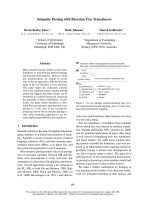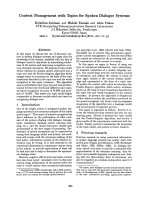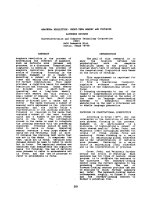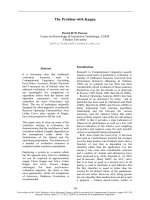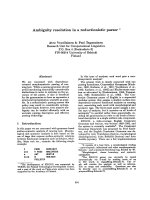Báo cáo khoa học: "Ellipsis Resolution with Underspecified Scope" docx
Bạn đang xem bản rút gọn của tài liệu. Xem và tải ngay bản đầy đủ của tài liệu tại đây (109.28 KB, 8 trang )
Ellipsis Resolution with Underspecified Scope
Michael Schiehlen
Institute of Natural Language Processing
Azenbergstr. 12
70174 Stuttgart
Fed. Rep. of Germany
Abstract
The paper presents an approach to ellipsis
resolution in a framework of scope under-
specification (Underspecified Discourse
Representation Theory). It is argued that
the approach improves on previous pro-
posals to integrate ellipsis resolution and
scope underspecification (Crouch, 1995;
Egg et al., 2001) in that application pro-
cesses like anaphora resolution do not re-
quire full disambiguation but can work
directly on the underspecified representa-
tion. Furthermore it is shown that the ap-
proach presented can cope with the exam-
ples discussed by Dalrymple et al. (1991)
as well as a problem noted recently by
Erk and Koller (2001).
1 Introduction
Explicit computation of all scope configurations is
apt to slow down an NLP system considerably.
Therefore, underspecification of scope ambiguities
is an important prerequisite for efficient processing.
Many tasks, like ellipsis resolution or anaphora res-
olution, are arguably best performed on a represen-
tation with fixed scope order. An underspecification
formalism should support execution of these tasks.
This paper aims to upgrade an existing underspec-
ification formalism for scope ambiguities, Under-
specified Discourse Representation Theory (UDRT)
(Reyle, 1993), so that both ellipsis and anaphora res-
olution can work on the underspecified structures.
Many thanks for discussion and motivation are due to the
colleagues in Saarbrücken.
Several proposals have been made in the lit-
erature on how to integrate scope underspecifica-
tion and ellipsis resolution in a single formalism,
e.g. Quasi-Logical Forms (QLF) (Crouch, 1995)
and the Constraint Language for Lambda Structures
(CLLS) (Egg et al., 2001). That work has primar-
ily aimed at devising methods to untangle quanti-
fier scoping and ellipsis resolution which often in-
teract closely (see Section 6). To this end, descrip-
tion languages have been modelled in which the dis-
ambiguation steps of a derivation need not be exe-
cuted but rather can be explicitly recorded as con-
straints on the final structure. Constraints are only
evaluated when the underspecified representation is
finally interpreted. In contrast, UDRT aims at pro-
viding a representation formalism that supports in-
terpretation processes such as theorem proving and
anaphora resolution. Understood in this sense, un-
derspecification often obviates the need for com-
plete disambiguation. Another consequence is, how-
ever, that the strategy of postponing disambigua-
tion steps is in some cases insufficient. A case
in point is the phenomenon dubbed Missing An-
tecedents by Grinder and Postal (1971), illustrated
in sentence (1): One of the pronoun’s antecedents
is overt, the other is supplied by ellipsis resolution.
(1) Harry sank a destroyer
and so did Bill and
they both went down with all hands. (Grinder
and Postal, 1971, 279)
Most approaches to ellipsis and anaphora resolution,
e.g. (Asher, 1993; Crouch, 1995; Egg et al., 2001),
can readily derive the reading. But consider:
(2) Harry sometimes reads a book about a sea-
battle and so does Bill. They borrow those
books from the library.
Computational Linguistics (ACL), Philadelphia, July 2002, pp. 72-79.
Proceedings of the 40th Annual Meeting of the Association for
Example (2) still retains five readings (Are there two
or even more books? are there one, two, or more
than two sea-battles?). An underspecified represen-
tation should not be committed to any of these read-
ings, but it should specify that “
a book
” has narrow
scope with respect to the conjunction. Furthermore,
an approach to underspecification and ellipsis reso-
lution should make clear why this representation is
to be constructed for the discourse (2). While QLF
fails the first requirement (a single representation),
CLLS fails the second (triggers for construction).
(3) * A destroyer
went down in some battle and a
cruiser did too. Harry sank both destroyers .
The discourse in (3) is not well-formed. But none
of the approaches mentioned can ascertain this fact
without complete scope resolution (or ad-hoc re-
strictions).
The paper is organized as follows. Section 2 gives
a short introduction to UDRT. Section 3 formulates
the general setup of ellipsis resolution assumed in
the rest of the paper. Section 4 presents a proposal
to deal with scope parallelism in an underspecified
representation. Section 5 shows how ellipsis can be
treated if it is contained in its antecedent. Section 6
describes a way to model the interaction of ellipsis
resolution and scope resolution in an underspecified
structure. In section 7 strict and sloppy identity is
discussed. Section 8 concludes.
2 Underspecified Discourse
Representation Structures
Reyle (1993) proposes a formalism for under-
specification of scope ambiguity. The under-
specified representations are called Underspeci-
fied Discourse Representation Structures (UDRSs).
Completely specified UDRSs correspond to the
Discourse Representation Structures (DRSs) of
Kamp and Reyle (1993). A UDRS is a triple con-
sisting of a top label, a set of labelled conditions
or discourse referents, and a set of subordination
constraints. A UDRS is (partially) disambiguated
by adding subordination constraints. A UDRS must,
however, always comply with the following well-
formedness conditions: (1) It does not contain cy-
cles (subordination is a partial order). (2) No label
is subordinated to two labels which are siblings, i.e.
part of the same complex condition (subordination
is a tree order).
Figure 1 shows the UDRS for sentence 4 in formal
and graph representation.
(4) Every professor found most solutions.
l0
l5: every( x, l1: , l2: )
l8: professor( x ) l9: solution( y )
l7: find( x, y )
x l6: most( y, l3: ,l4: )
y
,
{ every , { ,
professor , ,
most , ,
,
solution , ,
find }, ,
}
Figure 1: UDRS for sentence (4)
For pronouns and definite descriptions another
type of constraint is introduced, accessibility con-
straints. is accessible from ( acc ) iff
or and is a right sibling of
in a condition expressing material implication or a
generalized quantifier (Kamp and Reyle, 1993). An
accessibility constraint acc indicates that is
an anaphoric element or a presupposition; it thus
can be used as a trigger for anaphora resolution and
presupposition binding (van der Sandt, 1992). To
bind an anaphor to some antecedent expression ,
a binding constraint ( ) and an equality
constraint between two discourse referents are intro-
duced. Binding constraints are interpreted as equal-
ity in the subordination order. Any unbound presup-
positions remaining after anaphora resolution (cor-
responding to accessibility constraints without bind-
ing constraints) are accommodated, i.e. they end up
in an accessible scope position which is as near to
the top as possible. Figure 2 shows the UDRS for
sentence (5). Accessibility constraints are marked
by broken lines, binding constraints are shown as
squiggles.
(5) John revised his paper.
l7: revise( x, y )
l4: paper( y )
of( y, z )
l6: z = x
l5: z
l1: x
l2: John( x )
l3: y
l0
,
{
, { acc ,
John , ,
, acc ,
paper , ,
of ,
, acc ,
gender masc, ,
, ,
revise }, }
Figure 2: UDRS for sentence (5)
3 Ellipsis Resolution
Sag (1976) and Williams (1977) have argued con-
vincingly that VP ellipsis should be resolved on a
level where scope is fixed. Dalrymple et al. (1991)
distinguish two tasks in ellipsis resolution:
1. determining parallelism, i.e. identifying the
source clause
(the antecedent of the ellip-
sis), the parallel elements in the source clause
, the parallel elements in the target
(i.e. elliptical) clause , and the non-
parallel elements in the target ,
2. interpreting the elliptical (target)
clause , given the interpretation of
.
The paper does not have much to say about task 1.
Rather, some “parallelism” module is assumed to
take care of task 1. This module determines the
UDRS representations of the source clause and of
the source and target parallel elements. It also pro-
vides a bijective function associating the parallel
labels and discourse referents in source and target.
For task 2 we adopt the substitutional approach
advocated by Crouch (1995): The semantic rep-
resentation of the target is a copy of the
source where target parallel elements have been
substituted for source parallel elements (
). In contrast to Higher-Order
Unification (HOU) (Dalrymple et al., 1991) sub-
stitution is deterministic: Ambiguities somehow
cropping up in the interpretation process (i.e. the
strict/sloppy distinction) require a separate explana-
tion.
4 Scope Parallelism
It has frequently been observed that structural ambi-
guity does not multiply in contexts involving ellip-
sis: A scope ambiguity associated with the source
must be resolved in the same way in source and tar-
get. Sentence (6) e.g. has no reading where all pro-
fessors found the same solution but the students who
found a solution each found a different one.
(6) Every professor found a solution, and most stu-
dents did, too.
Scope parallelism seems to be somewhat at odds
with the idea of resolving ellipses on scopally under-
specified representations. If the decisions on scope
order have not yet been taken, how can they be guar-
anteed to be the same in source and target? The
QLF approach (Crouch, 1995) gives an interesting
answer to this question: It uses re-entrancy to prop-
agate scope decisions among parallel structures.
In sentence (6), we see that a scope decision can
resolve more than one ambiguity. In UDRT, scope
decisions are modelled as subordination constraints.
Consequently, sentence (6) shows that subordina-
tion constraints may affect more than one pair of
labels. Remember that in each process of ellipsis
resolution the parallelism module returns a bijec-
tive function which expresses the parallelism be-
tween labels and discourse referents in source and
target. As sentence (6) shows, a subordination con-
straint that links two source labels and also links
the labels corresponding to and in a parallel
structure , i.e. and for all . Thus
the subordination constraint does not distinguish be-
tween source label and parallel labels. Formally, we
define two labels and to be equivalent ( )
iff
. Now we can model the par-
allelism effects by stipulating that a subordination
constraint connects two equivalence classes
and rather than two individual labels and .
But every label in one class should not be linked
to every label in the other class. If and are
the source labels, it does not make sense, and actu-
ally will often lead to a structure violating the well-
formedness conditions, to connect e.g. the source
label with some target label . Thus we still
need a proviso that only such labels can be linked
that were determined to be parallel to the source la-
bel in the same sequence of ellipsis resolutions. We
talk about a sequence here, because, as sentence (7)
shows, ellipses may be nested.
(7) John arrived before the teacher did (1 arrive),
and Bill did too (2 arrive before the teacher did
(1 arrive)).
For the implementation of classes, we take our cues
from Prolog (Erbach, 1995; Mellish, 1988). In Pro-
log, class membership is most efficiently tested via
unification. For unification to work, the class mem-
bers must be represented as instances of the repre-
sentation of the class. If class members are mutually
exclusive, their representations must have different
constants at some argument position. In this vein,
we can think of a label as a Prolog term whose func-
tor denotes the equivalence class and whose argu-
ment describes the sequence of ellipsis resolutions
that generated the label. Such a sequence can be
modelled as a list of numbers which denote reso-
lutions of particular ellipses. An empty list indi-
cates that the label was generated directly by se-
mantic construction. We will call the list of reso-
lution numbers associated with a label the label’s
context. For reasons that will become clear only
in section 7 discourse referents also have contexts.
Although subordination constraints connect classes
of labels, they are always evaluated in a particular
context. Thus
(or, more explicitly,
) can be spelled out as or
, but never because in this
case context changes.
While scope resolution is subject to parallelism
and binding is too (see Section 7), examples like (9)
suggest that accommodation sites need not be par-
allel
1
. (“
The jeweler
” is accommodated with wide
1
Asher et al. (2001) use parallelism between subordination
and accommodation to explain the “wide-scope puzzle” ob-
served by Sag (1976). Sentence (8) has only one reading: A
specific nurse saw all patients.
(8)
A nurse saw every patient. Dr. Smith did too.
scope, but “
his wife
” is not.)
(9) If Peter is married, his wife is lucky and the
jeweler is too.
Ellipsis resolution works as follows. In semantic
construction, all occurrences of labels and discourse
referents (except those in subordination constraints)
are assigned the empty context ( ). Whenever an
occurrence of ellipsis is recognized, a counter is in-
cremented. Let be the counter’s new value. All
parallel labels and discourse referents in the tar-
get are replaced by their counterparts in the source
( and ). After substitution proper (
), the new resolution number
is added to the context of every label and discourse
referent in . Finally, the non-parallel target ele-
ments ( ), if any, are added to the seman-
tic representation of the target. Figure 3 shows the
UDRS for sentence (6) after ellipsis resolution.
,
{
every , { ,
,
professor , ,
, ,
solution , ,
find , ,
and , }
most ,
,
student ,
,
solution ,
find },
Figure 3: UDRS for sentence (6)
Erk and Koller (2001) discuss sentence (10)
which has a reading in which each student went
to the station on a different bike. The example is
problematic for all approaches which assume source
and target scope order to be identical (HOU, QLF,
CLLS).
(10) John went to the station, and every student did
too, on a bike.
Erk and Koller (2001) go on to propose an extension
of CLLS that permits the reading. In the approach
proposed here no special adjustments are needed:
The indefinite NP is designated by labels that do not
have counterparts in the source. The subordination
order is still the same in source and target.
5 Antecedent-Contained Ellipsis
The elliptical clause can also be contained in the
source, cf. example (11).
(11) John greeted every person that Bill did.
In this case the quantifier embedding the elliptical
clause necessarily takes scope over the source. The
treatment of this phenomenon in QLF and CLLS,
which consists in checking for cyclic formulae af-
ter scope resolution, cannot be transferred to UDRT,
since it presupposes resolved scope. Rather we
make a distinction between proposed source and ac-
tual source. If the target is not contained in the
(proposed) source, the actual source is the proposed
source. Otherwise, the actual source is defined to be
that part of the proposed source which is potentially
subordinated
2
by the nuclear scope of the quantifier
whose restriction contains the target.
6 Interaction of Ellipsis Resolution and
Quantifier Scoping
Sentence (6) has a third reading in which the in-
definite NP “
a solution
” is raised out of the source
clause and gets wide scope over the conjunction. In
this case, the quantifier itself is not copied, only the
bound variables which remain in the source. Gen-
erally, a quantifier that may or may not be raised
out of the source is only copied if it gets scope in-
side the source. Thus the exact determination of the
semantic material to be copied (i.e. of the source)
is dependent on scope decisions. Consequently, in
an approach working on fully specified representa-
tions (Dalrymple et al., 1991) scope resolution can-
not simply precede ellipsis resolution but rather is
interleaved with it. Crouch (1995) considers order-
sensitivity of interpretation a serious drawback. In
his approach, underspecified formulae are copied in
ellipsis resolution. In such formulae, quantifiers are
not expressed directly but rather stored in “q-terms”.
Q-terms are interpreted as bound variables. Quan-
tifiers are introduced into interpreted structure only
when their scope is resolved. Since scope resolution
is seen as constraining the structure rather than as an
operation of its own, the QLF approach manages to
2
is potentially subordinated to in a UDRS iff the subor-
dination constraint
could be added to the UDRS without
violating well-formedness conditions.
untangle scope resolution and ellipsis resolution. In
CLLS (Egg et al., 2001) no copy is made in the un-
derspecified representation. In both approaches, the
quantifier is not copied until scope resolution.
But the Missing Antecedents phenomenon (1)
shows that a copy of the quantifier must be avail-
able even before scope resolution so that it can serve
as antecedent. But this copy may evaporate later
on when more is known about the scope configura-
tion. We will call conditions that possibly evaporate
phantom conditions. For their implementation we
make use of the fact that a UDRS collects labelled
conditions and subordination constraints in sets. In
sets, identical elements collapse. Thus, a condition
that is completely identical to another condition will
vanish in a UDRS. Phantom conditions only arise
by parallelism; hence they are identical to their orig-
inals but for the context of their labels and discourse
referents. To capture the effect of possible evapora-
tion, it suffices to make the update of context in a
phantom condition dependent on the relevant scope
decision. To implement phantom conditions in a
Prolog-style environment, we insert a meta-variable
in place of the context and control its instantiation
by a special constraint expressing the dependence
on the pertinent subordination constraint (a condi-
tional constraint). Conditional constraints have the
form
K K where is the con-
text variable, is a resolution number, and K is some
context.
,
{
every , { ,
,
professor , ,
, ,
solution , ,
find , ,
and , ,
most ,
,
student ,
,
solution ,
find },
}
Figure 4: UDRS for sentence (6)
Figure 4 illustrates a UDRS with a phantom con-
dition (again representing sentence (6)). A graphical
l6: solution( y )
l1: every(x,l2: ,l3: )
x
l0
X
l8: before( l9 , l9 )
Z
l1: most(x,l2: ,l3: )l1: every(x,l2: ,l3: )
l4: professor( x )
l6: solution( y )
l1: most(x,l2: ,l3: )
l4: student( x )
l7: find( x, y )
l7: find( x, y )
l4: assistant( x )
l4: student( x )
l7: find( x, y )l7: find( x, y )
l8: before( l9 , l9 )
x
x x
l10: and( l11, l11)
l5: y
l5: y
l5: y
l6: solution( y )
l6: solution( y )
Y
l5: y
Z=[2|X]
X=[1]
Y=[2]
1
2
1
Figure 5: UDRS for sentence (12)
representation of this UDRS can be seen in the first
conjunct of Figure 5. Contexts are marked by dotted
boxes, conditional constraints by a dotted subordi-
nation link with an equation.
If the subsequent discourse contains a plural
anaphoric NP such as “
both solutions
”, two or more
discourse referents designating solutions are looked
for. Two such discourse referents are found ( and
), but they will collapse unless is set to .
After consultation of the conditional constraint, the
subordination constraint is added. If the sub-
sequent discourse contains a singular anaphoric NP
“
the solution
”, anaphora resolution introduces the
converse subordination constraint .
Examples involving nested ellipsis (cf. sen-
tence (12)) require copying of context variables and
conditional constraints.
(12) Every professor found a solution before most
students did, and every assistant did too.
To copy a context variable , it is replaced by a new
variable . The conditional constraint evaluating
( ) is copied to a conditional con-
straint evaluating . In this constraint is condi-
tionally bound back to :
, where is the new resolution number and is
the top label of the source. Consider the UDRS for
sentence (12) in Figure 5 with three conditional con-
straints:
,
, and . The ex-
istential NP “
a solution
” is copied three times (if
), once (if and ), or not at all
(if ).
7 Strict and Sloppy Identity
In the treatment of strict/sloppy ambiguity, we fol-
low the approach of Kehler (1995) which predicts
five readings for the notorious example (13) from
Gawron and Peters (1990).
(13) John revised his paper before the teacher did,
and Bill did too.
In Kehler’s (1995) approach, strict/sloppy am-
biguity results from a bifurcation in the process
of ellipsis resolution: There are two ways to copy
the binding constraint linking an anaphor with its
antecedent if the antecedent is in the source
3
. Let
K K J , K J be a binding
constraint as introduced by anaphora resolution.
The sloppy way to copy the constraint is the usual
one, i.e. updating the contexts with the new resolu-
tion number.
3
If the antecedent of a pronoun is outside the source,
the copied pronoun is bound to the source pronoun (strict
interpretation), not directly to the antecedent, cf. the reading
missing in sentence (14) in which Bill will say that Mary
helped Bill before Susan helped John.
(14) John will testify that Mary helped him before Susan
did, and so will Bill.
l8: before( l9 , l9 )
l1: x
John(x)
l3: z
z=x
l4: y
paper(y,z)
l7: revise( x, y )
l4: y
paper(y,z)
l7: revise( x, y )
l3: z
z=x
l8: before( l9 , l9 )l3: z
z=z[]
l1: x
teacher(x)
l4: y
paper(y,z)
l7: revise( x, y )
l3[]
l1: x
teacher(x)
l4: y
paper(y,z)
l7: revise( x, y )
l0
l10: and( l11, l11)
l1: x
Bill(x)
z=z[1]
l3: zl3[1]
21
1
Figure 6: UDRS for a reading of sentence (13)
sloppy K K J , K J
The strict way is to bind the variable of the
copied pronoun to the variable of the source pro-
noun.
strict K K K , K K
Figure 6 shows the UDRS for a particular reading
of sentence (13): John and Bill revised their own
papers before the teacher revised John’s paper. The
pronoun is first copied strict ( ),
then sloppy ( ), and finally strict again
( ).
We have tacitly assumed that source pronouns are
resolved before ellipsis resolution. No mechanism
has been provided to propagate binding constraints
in parallel structures. But note that the order of op-
erations in anaphora resolution is also constrained
by structure: Anaphors embedded in other anaphors
need to be resolved first (van der Sandt, 1992). El-
lipsis resolution may be considered on a par with
anaphora resolution in this respect.
Anaphors can occur in phantom conditions as
well (cf. sentence (15)).
(15) John revised a paper of his before the teacher
did, and Bill did too.
An extension of the copy rules for binding con-
straints along the lines of Section 6 is straightfor-
ward (see below). If the embedding quantifier gets
wide scope ( ), source and target constraints
collapse (sloppy), or the target constraint asserts
self-binding (strict).
sloppy , ,
strict
K , K
K K ,
J J
There are, however, some problems with this exten-
sion. See Figure 7 for the strict-sloppy-strict read-
ing of sentence (15). If the indefinite NP gets in-
termediate scope between “
before
” and “
and
”, the
context variable will be set to , and to .
A clash follows, since is bound both to
and . To remedy this defect, we stipulate that
resolving the strict/sloppy ambiguity may partially
disambiguate the scope structure: If in the course of
resolving a particular ellipsis several anaphors are
copied with different choices in the strict/sloppy bi-
furcation, the conditional constraints are evaluated
so that the anaphors cannot turn out to be the same.
This condition ensures that in the strict-sloppy-strict
reading illustrated in Figure 7 the indefinite NP gets
narrow scope under “
before
”.
8 Conclusion
The paper has presented a new approach to inte-
grate ellipsis resolution with scope underspecifica-
tion. In contrast to previous work (Crouch, 1995)
l7: revise( x, y ) l7: revise( x, y )
l1: x
teacher(x)
l4: y
paper(y,z)
l3: z
z=x
l1: x
John(x)
l8: before( l9 , l9 )
l7: revise( x, y )
l1: x
teacher(x)
l7: revise( x, y )
l8: before( l9 , l9 )
l0
l10: and( l11, l11)
l4: y
paper(y,z)
paper(y,z)
l4: y
l1: x
Bill(x)
l3: z
z=x
paper(y,z)
l4: y
X
1
X=[1]
l3[]
z=z[]
l3: z
Z
Z=[2|X]
Y
Y=[2]
1
l3: z
z=z(X)
2
l3(X)
Figure 7: UDRS for sentence (15)
(Egg et al., 2001) the proposed underspecified rep-
resentation facilitates the resolution of anaphora by
providing explicit representations of potential an-
tecedents. To this end, a method to encode “phan-
tom conditions” has been presented, i.e. subformu-
lae whose presence depends on the scope configu-
ration. Furthermore, a method to deal with scope
parallelism in scopally underspecified structures has
been proposed. The proposed method has no trou-
ble accounting for cases where the scope order in
antecedent clause and elliptical clause is not entirely
identical (Erk and Koller, 2001). Finally, it has been
shown that the approach can cope with a wide vari-
ety of test examples discussed in the literature.
References
Nicholas Asher, Daniel Hardt, and Joan Busquets. 2001.
Discourse Parallelism, Ellipsis, and Ambiguity. Jour-
nal of Semantics, 18(1).
Nicholas Asher. 1993. Reference to Abstract Objects in
Discourse. Kluwer.
Richard Crouch. 1995. Ellipsis and Quantification: A
Substitutional Approach. In Proceedings of EACL’95,
pages 229–236, Dublin, Ireland.
Mary Dalrymple, Stuart M. Shieber, and Fernando C.N.
Pereira. 1991. Ellipsis and Higher-Order Unification.
Linguistics and Philosophy, 14:399–452.
Markus Egg, Alexander Koller, and Joachim Niehren.
2001. The Constraint Language for Lambda Struc-
tures. Journal of Logic, Language and Information,
10.
Gregor Erbach. 1995. ProFIT: Prolog with Features, In-
heritance and Templates. In Proceedings of EACL’95,
Dublin, Ireland.
Katrin Erk and Alexander Koller. 2001. VP Ellipsis by
Tree Surgery. In Proceedings of the 13th Amsterdam
Colloquium.
Jean Mark Gawron and Stanley Peters. 1990. Anaphora
and Quantification in Situation Semantics. Number 19
in CSLI Lecture Notes. Center for the Study of Lan-
guage and Information, Stanford, CA.
John Grinder and Paul M. Postal. 1971. Missing An-
tecedents. Linguistic Inquiry, 2:269–312.
Hans Kamp and Uwe Reyle. 1993. From Discourse to
Logic: An Introduction to Modeltheoretic Semantics
of Natural Language. Kluwer.
Andrew Kehler. 1995. Interpreting Cohesive Forms in
the Context of Disocurse Inference. Ph.D. thesis, Har-
vard University.
Chris Mellish. 1988. Implementing Systemic Classi-
fication by Unification. Computational Linguistics,
14:40–51.
Uwe Reyle. 1993. Dealing with Ambiguities by Under-
specification: Construction, Representation and De-
duction. Journal of Semantics, 10(2):123–179.
Ivan Sag. 1976. Deletion and Logical Form. Ph.D. the-
sis, MIT.
Rob A. van der Sandt. 1992. Presupposition Projec-
tion as Anaphora Resolution. Journal of Semantics,
9(4):333–377.
Edwin Williams. 1977. Discourse and Logical Form.
Linguistic Inquiry, 8(1):101–139.


